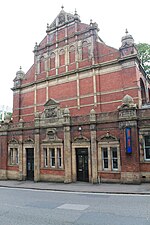City of Bristol College
1996 establishments in EnglandEducational institutions established in 1996Further education colleges in BristolHigher education colleges in EnglandLearning and Skills Beacons

City of Bristol College is a further education and higher education college in Bristol, England. It provides courses for young people and adults aged 16 and above in areas such as: A Levels, Animal Care, Floristry, Horticulture, Applied Forensic and Medical Science, Business, Catering and Hospitality, Computing, Construction, Creative and Performing Arts, Engineering and Manufacturing, ESOL and GCSEs, Hair, Beauty and Holistic Therapies, Health and Social Care and Childcare, Motor Vehicle and Transport, Public Services, Health and Fitness, Travel and Tourism and many more.
Excerpt from the Wikipedia article City of Bristol College (License: CC BY-SA 3.0, Authors, Images).City of Bristol College
Saint Georges Road, Bristol City Centre
Geographical coordinates (GPS) Address Phone number External links Nearby Places Show on map
Geographical coordinates (GPS)
| Latitude | Longitude |
|---|---|
| N 51.45091 ° | E -2.60553 ° |
Address
College Green Centre
Saint Georges Road
BS1 5UA Bristol, City Centre
England, United Kingdom
Open on Google Maps








